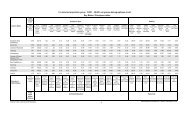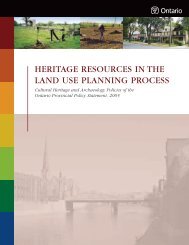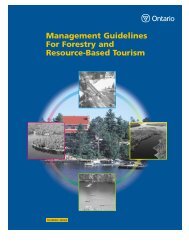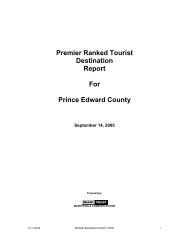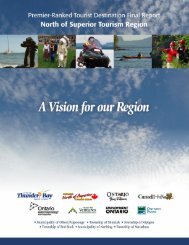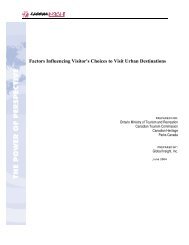Engaging Aboriginal Communities in Archaeology - Ministry of ...
Engaging Aboriginal Communities in Archaeology - Ministry of ...
Engaging Aboriginal Communities in Archaeology - Ministry of ...
- No tags were found...
Create successful ePaper yourself
Turn your PDF publications into a flip-book with our unique Google optimized e-Paper software.
It is an effective approach to try to build a long-term relationship with the community byencourag<strong>in</strong>g participation and ma<strong>in</strong>ta<strong>in</strong><strong>in</strong>g contact through regular communication. Suchrelationships can:ease the exchange <strong>of</strong> <strong>in</strong>formation;promote shared understand<strong>in</strong>g <strong>of</strong> <strong>in</strong>terests;build communication channels; andfacilitate and expedite future archaeological projects.3.3 Incorporat<strong>in</strong>g Input from the <strong>Aborig<strong>in</strong>al</strong> communityAs noted <strong>in</strong> Part 1 <strong>of</strong> this bullet<strong>in</strong>, when recommend<strong>in</strong>g avoidance and protection orexcavation for certa<strong>in</strong> types <strong>of</strong> archaeological sites, you must engage <strong>Aborig<strong>in</strong>al</strong>communities <strong>in</strong> the development <strong>of</strong> a strategy to mitigate impacts to the site.The standards and guidel<strong>in</strong>es make it clear that avoidance and protection is the preferredoption for archaeological sites with cultural heritage value or <strong>in</strong>terest. This optionpreserves the sites <strong>in</strong>tact [See Standards and Guidel<strong>in</strong>es for Consultant Archaeologists, Section4.1].It is good practice to discuss mitigation options with the <strong>Aborig<strong>in</strong>al</strong> community early<strong>in</strong> the archaeological project, ensure that the options are clearly understood, and documentthe community’s preference. You must consider the <strong>in</strong>put <strong>of</strong> the <strong>Aborig<strong>in</strong>al</strong> community atthe po<strong>in</strong>t when you make mitigation recommendations. However, because proponentshave the greatest flexibility at the start <strong>of</strong> a development project, it is a good idea to makethe community’s preference known to your client as early as possible.Where your recommendations do not reflect the community’s preference, you shouldcommunicate this to your client as early as possible as well.The standards and guidel<strong>in</strong>es do not require you to negotiate agreements between the<strong>Aborig<strong>in</strong>al</strong> community and your client.Other effective strategies to <strong>in</strong>corporate <strong>in</strong>put from <strong>Aborig<strong>in</strong>al</strong> communities could <strong>in</strong>cludethe follow<strong>in</strong>g:Gather <strong>in</strong>formation <strong>in</strong> the language <strong>of</strong> the <strong>Aborig<strong>in</strong>al</strong> community <strong>in</strong>volved. Valuablecultural <strong>in</strong>formation encoded <strong>in</strong> language can be lost <strong>in</strong> translation to English orFrench. <strong>Engag<strong>in</strong>g</strong> with speakers <strong>of</strong> the community’s language, either directly orthrough a translator, may yield better <strong>in</strong>sights <strong>in</strong>to the archaeological site, its function,or the traditional uses <strong>of</strong> that area.Adjust fieldwork processes or strategies, as <strong>in</strong> the follow<strong>in</strong>g examples: work <strong>Aborig<strong>in</strong>al</strong> ceremonies <strong>in</strong>to the fieldwork process;Draft <strong>Engag<strong>in</strong>g</strong> <strong>Aborig<strong>in</strong>al</strong> <strong>Communities</strong> <strong>in</strong> <strong>Archaeology</strong> | 10



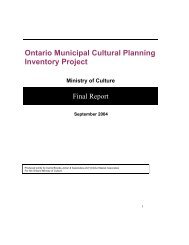
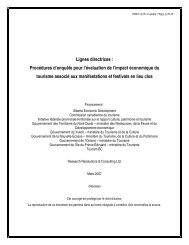
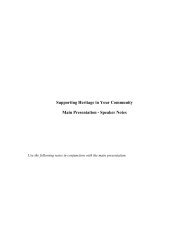
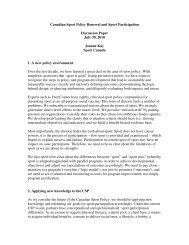
![THIS AGREEMENT made this [date], between [name of owner] (the ...](https://img.yumpu.com/49827605/1/158x260/this-agreement-made-this-date-between-name-of-owner-the-.jpg?quality=85)

